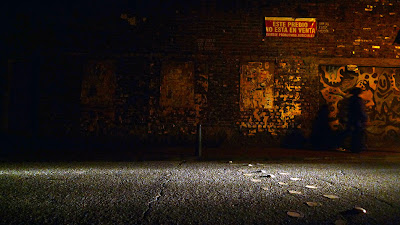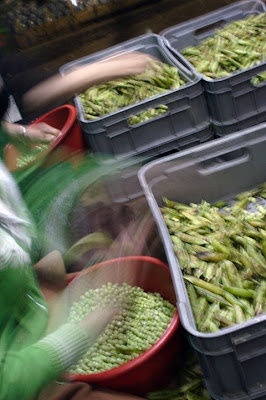Yesterday, we heard the doorbell at 5 a.m. and opened it to find our friend Edilberto Criollo, who has just arrived from San Agustin. I met Edilberto through my flatmate, Tamara who went to see him in Putumayo (Southern Colombia) at the beginning of the year. She travelled two days to that so-called "no-go place" to meet him at the Cofan community.
To the best of our present knowledge, the Cofan culture probably has its roots in proto-Chibchan hunters who wandered down from the Colombian highlands near the present border of Colombia and Ecuador some time in the distant past.
My friend went there to experience on the most incredible experiences you might have: the in taking of yagé (Ayahuasca) which is used largely as a religious sacrament. Those whose usage of ayahuasca is performed in non-traditional contexts often align themselves with the philosophies and cosmologies associated with ayahuasca shamanism, as practiced among indigenous peoples.
Edilberto belongs to a family of Cofan Shamans and he himself is one of the most respected Shamans in the whole country. He travels all over Colombia to perform the religious ritual of yagé, which I was very surprised to know is a very popular practice amongst many Colombians.
He has been travelling all night, so we invited him to have some rest. Later, we have breakfast and he told me whether I would like to join him that night in a small village in the mountains near Bogota where he was going to perform the ceremony. After thinking all day about it, I decided to go not before asking him if I could take some pictures of the ritual. He agreed and we packed some blankets, water, cameras... "Would you like to be part of the ceremony of yagé, Juan?" I wasn't prepared to answer that.
After one hour driving in the dark through the mountains we eventually arrived at a farm, where Juan welcomed us. There were more people coming soon... The place where the ceremony was going to take place was a Maloca.
A maloca is an ancestral long house used by the natives of the Amazon, notably in Colombia and Brazil. Each community has a maloca with its own unique characteristics. For many years, these long houses were Jesuit missionaries’ objects of attack. Several families with patrilineal relations live together in a maloca, distributed around the long house in different compartments. In general, the chief of the local descent group lives in the compartment nearest to the back wall of the long house. As well, each family has its own furnace.
During festivals and in formal ceremonies, which involve dances for males, the long house space is rearranged; the centre of the long house is the most important area where the dance takes place.
Our Maloca was round with two doors, one for males, the other for women. Whereas we waited for the others to arrived I looked up and an incredible clear and starry sky was embracing us.I felt overwhelmed and excited about what was going to happen. However, I decided not to take yagé. There was something inside me, some painful memories than made me feel it was not going to be a good experience. So I told Edilberto, that I will participate as an observant that I will take pictures of the ceremony if people agreed with that.
.jpg)

.jpg)
.jpg)
.jpg)
.jpg) It was indeed, an incredibly beautiful experience; everyone had taken it before but one girl. The Shaman reassured her that she had nothing to be afraid of.It was midnight when we started: one by one was called and they drank the yagé, prepared by the Shaman.
It was indeed, an incredibly beautiful experience; everyone had taken it before but one girl. The Shaman reassured her that she had nothing to be afraid of.It was midnight when we started: one by one was called and they drank the yagé, prepared by the Shaman.
While non-native users know of the spiritual applications of ayahuasca, a less well-known traditional usage focuses on the medicinal properties of ayahuasca. Its purgative properties are highly important (many refer to it as la purga, "the purge"). The intense vomiting and occasional diarrhea it induces can clear the body of worms and other tropical parasites, and harmala alkaloids themselves have been shown to be anthelmintic. And this is exactly what happened. One by one, each participant stood up and walked outside where they threw one and twice. Then, they would walked back inside and sat at the fireplace. The Shaman would start rhythmic chants whereas dancing around us.
The Chilean novelist Isabel Allende told a British newspaper that she once took the drug in an attempt to "punch through" writer's block. The paper wrote:
But after forcing down the foul-tasting brew, she was catapulted to a place so dark her husband feared he had 'lost his wife to the world of spirits'. Her life flashed before her as the hallucinogen took hold. She faced demons, saw herself as a terrified four-year-old and curled up on the floor, shivering, retching and muttering for two days.
'I think I went through an experience of death at a certain point, when I was no longer a body or a soul or a spirit or anything,' Allende says matter-of-factly. 'There was just a total, absolute void that you cannot even describe because you are not. And I think that's death.'
Nevertheless, the process proved transformative. Allende emerged aching but lucid and was able to complete [a trilogy she was writing], now being adapted for film by the co-producers of The Chronicles of Narnia.
I spent all night walking around the Maloca and sitting at the fireplace listening the Shaman's chants and music. I felt strangely relaxed and connected with everything around me. For the first time since my arrival in Colombia, I cried...







.jpg)

.jpg)
.jpg)
.jpg)
.jpg)























.jpg)














